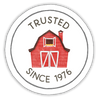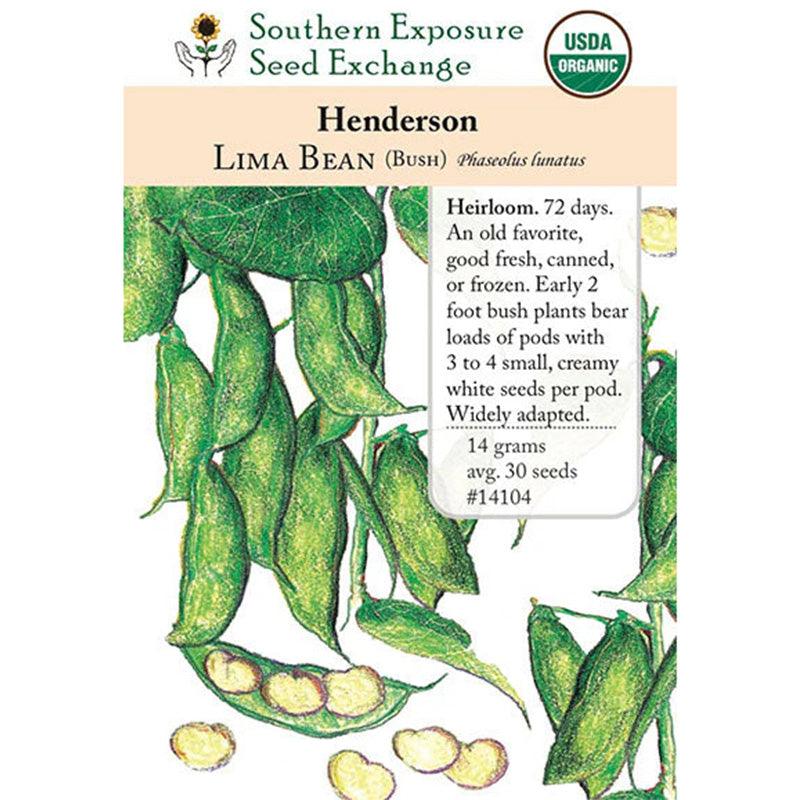Item Number: SNV2001
Henderson Lima Bush Bean Seeds (Organic)
Bushy Form, High Yield, Creamy Taste
- Maturity: 72 days
- Plant Height: Bushy 2 ft. plants
- Pod Size: Flat 3-inch baby pods
- Seeds per Pod: 3-4 small, creamy white seeds per pod
- Production: Heavy producer, continues until frost
- Uses: Good fresh, canned, or frozen
- Special Characteristics: Disease-resistant, hardy, nitrogen-fixer
Henderson Lima Bush Beans are a classic and dependable variety of lima beans, prized by gardeners for their compact growth, high productivity, and creamy, buttery flavor. Known for their versatility in both fresh and preserved forms, Henderson Lima Bush Beans are a fantastic addition to any home garden. With early maturity, disease resistance, and compact size, these beans are a great choice for gardeners with limited space or those looking to grow a reliable source of protein and fiber in their backyard.
Planting Henderson Lima Bush Seeds
Henderson Lima Bush Beans thrive when planted directly in the garden after the last frost date. Since they mature in just 72 days, they can be one of the earliest harvested beans in the season. Plant Henderson Bush seeds directly into warm soil, as beans generally dislike being transplanted.
Plant seeds about 1-2 inches deep and space them 3-4 inches apart in rows. If planting in multiple rows, leave about 18-24 inches between rows to allow for adequate air circulation, which helps prevent disease. Soil temperatures should ideally be above 65°F for optimal germination, and the plants perform best in well-drained, slightly acidic to neutral soil with a pH between 6.0 and 6.8.
Soil Preparation and Nutrient Needs
Henderson Lima Bush Beans are hardy and can grow in most soil conditions, but they perform best in well-drained, fertile soil. They are nitrogen-fixing plants, meaning they enrich the soil by adding nitrogen, which benefits the growth of future crops. For best results, consider using an inoculant for legumes when planting Henderson Bush seeds.
This inoculant encourages the development of nitrogen-fixing bacteria on the plant roots, which helps the plants grow better and improve soil health.
Since the beans produce their own nitrogen, avoid adding high-nitrogen fertilizers to the soil. Too much nitrogen encourages foliage growth rather than bean production. Instead, focus on phosphorus and potassium, which support pod formation and root health.
Growing Conditions and Care
The compact, bushy 2 ft. plants of the Henderson Lima Bush Beans make them easy to manage in most garden spaces. They are heavy producers that continue bearing until frost, provided they are grown in favorable conditions. Full sun is ideal, as it helps the beans develop faster and produce abundantly, though they can tolerate partial shade if necessary.
Water regularly, aiming for consistent soil moisture but avoiding waterlogged conditions. Mulching around the base of the plants can help retain moisture, keep roots cool, and prevent weeds. Additionally, mulch can help keep the beans cleaner by preventing soil from splashing onto the lower pods during rainfall or watering.
Companion Planting
Henderson Lima Bush Beans make excellent companions to a range of garden vegetables. Their nitrogen-fixing properties enrich the soil, benefiting heavy-feeding plants like tomatoes, corn, and carrots. Other great companion plants include cucumbers, squash, and radishes. Avoid planting beans near onions, garlic, and beets, as these crops can stunt each other’s growth. The beneficial relationships with companion plants, along with the beans’ compact nature, make them versatile additions to various garden layouts.
Pest and Disease Management
Henderson Lima Bush Beans are naturally disease-resistant, which is one of their most valuable traits. However, it’s essential to monitor for common bean pests, including aphids, bean beetles, and spider mites. Here are some tips for managing potential pest issues:
Row Covers: Lightweight row covers help protect young plants from pests.
Hand-Picking: Remove visible pests by hand, especially bean beetles and aphids.
Beneficial Insects: Encourage ladybugs, lacewings, and other beneficial insects to help control aphid populations.
Organic Sprays: If pests become problematic, insecticidal soap or neem oil can provide effective organic control.
Henderson Lima Bush Beans also benefit from crop rotation practices, helping to reduce the risk of soil-borne diseases. Rotating beans with other crop families each year helps keep the soil healthy and minimizes disease pressure.
Harvesting Henderson Lima Bush Beans
Henderson Lima Bush Beans reach maturity in about 72 days. Their flat, 3-inch pods contain 3-4 small, smooth, and tender creamy white seeds. You can harvest the beans at different stages depending on your intended use:
Young and Tender: Pick the pods while they are young and tender for fresh use. These young beans are deliciously buttery and delicate.
Mature: Let the beans mature fully on the plant if you want to store them for canning, freezing, or drying.
Frequent picking encourages the plants to continue producing, which means a steady supply of beans throughout the growing season. Since these beans produce until frost, you’ll likely enjoy multiple harvests.
Nutritional Benefits and Health Highlights
Henderson Lima Bush Beans are packed with nutrition, offering a great source of fiber, protein, and essential minerals, including magnesium. They are low in fat and are known to help improve circulation and oxygen delivery in the body due to their magnesium content. This nutrient profile makes them a valuable addition to a healthy diet, especially for individuals looking to boost protein and fiber intake without adding extra fat.
Uses for Henderson Lima Bush Beans
These beans are versatile in the kitchen and can be used in a variety of ways. Here are some popular uses:
- Fresh: Add young, tender beans to soups, stews, or salads for a touch of creamy texture and flavor.
- Canning: Henderson Lima Bush Beans are ideal for canning, as they hold up well to the process and provide a convenient way to enjoy your harvest during the winter months.
- Freezing: Blanch and freeze the beans for use throughout the year.
- Drying: Allow the beans to dry on the plant for a longer-lasting storage option. Dried beans are perfect for adding to hearty soups, stews, and casseroles.
End-of-Season Care and Soil Enrichment
Once you’ve harvested the final pods of the season, you can cut up the plants and work them back into the soil as a natural fertilizer. Because lima beans are nitrogen-fixers, they enrich the soil with valuable nutrients that benefit the next crop you plant in that space. This end-of-season practice not only adds organic matter to the soil but also improves soil structure and fertility, making it more suitable for future plantings.
Advantages of Growing Henderson Lima Bush Beans
Henderson Lima Bush Beans are incredibly reliable and easy to grow, making them ideal for beginner and experienced gardeners alike. With early maturity, these beans allow for a quick harvest, making them a great choice if you’re looking to enjoy the earliest of lima beans. Their disease resistance, compact growth habit, and heavy production make them an especially valuable variety for small gardens or urban spaces where space is limited.
Conclusion
Henderson Lima Bush Beans offer a combination of high productivity, early maturity, and excellent flavor that makes them a popular choice for home gardeners. Their compact, bushy growth habit allows them to thrive in a variety of settings, and their ability to produce until frost ensures a long, bountiful harvest. Whether you’re growing them for fresh eating, canning, freezing, or drying, Henderson Lima Bush Beans are a versatile, nutritious, and rewarding crop. With simple care requirements and adaptability to most soil conditions, these beans are an excellent addition to any garden.




Check Your Zone Compatibility:
Compatible with your zone.
Growing Zone for

Our Guarantee To You
Since 1976, we've served our customers at every stage of growing. Please contact us at any time. We are happy to support and assist you.
Shipping Information
Shipping Information
Shipping Weight: 0.01 lb
Dimensions: 4.5"L x 3.125"W x 0.1"H
Features
Features
- Fixes Nitrogen
- Good for Drying
- Good Keeper
- Open-Pollinated
Characteristics
Characteristics
Planting & Care
Planting & Care
Soil & Water: Legumes like well-drained soil rich in organic matter and a moderate amount of nutrients. Water lightly at planting, medium at flowering, and heavily throughout harvest time. Avoid overhead watering which can promote disease.
Planting & Growing: May start indoors in short-season climates, or sow seed directly once soils have reached at least 65°F, preferably after the last frost. Make small, successive plantings every 10 days for a continuous harvest.
Harvesting & Storage: Bush beans will produce all of their fruit over a few weeks' time. Leave the pods on the plant until they have completely dried. Store dry, shelled beans in an airtight container.
Useful Information
Useful Information
Guarantee
Guarantee
Share




